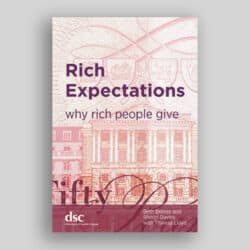By: Merriman Cuninggim The Role of Foundations in American Giving
McGraw-Hill Book Company
1221 Avenue of the Americas
New York N.Y. 10020
Some view the lawyer as one who carries out his clients’ instructions, and no more. Another view is that the lawyer performs a broad advisory task and evaluates the institutions to which he gives legal form. Merriman Cuninggim, President of the Danforth Foundation, has written “Private Money and Public Service”, a critical examination of the operation of the charitable foundation in American society. This book is important for the lawyer who wishes to properly assist his client to contribute towards the betterment of society.
The author defines these diverse and elusive entities known as foundations:
They “are non-governmental agencies, privately established and managed, but in which the public has a stake and which are answerable to Government, possessing financial resources, usually in the form of endowment, and existing to serve the general welfare or some chosen segment of it, usually in the form of grants.”. A prevalent public response to foundations and their work, has until recently, been one of respect, admiration and expectation that they will continue to carry out their good work. However, in recent years, the foundations have been confronted with a concerted attack on their motivations, financial operations and structure, as well as their programs and operating policies. The attack has found expression in the form of inquiries and investigations by Congress and the Treasury Department, and has resulted in the Tax Reform Act of 1969. Cuninggim tells the foundations that they must respond to the attack, and cannot adopt an ‘above-the-battle’ stance. He sets a good example in his response, when he resists the temptation to become defensive and to overstate his case. Instead, he confronts and grapples with the criticism. Where it is justified, he admits the shortcoming, and where the criticism is based on misinformation, he patiently explains.
To the argument that the Foundation is a ‘tax-dodge’, he responds that the system of taxation may be unfair, but the overwhelming majority of foundations (especially the large foundations, who control the greater portion of all the foundation funds) adhere to the law; that the instances of abuse are rare. Thus, the distinction between tax avoidance and taking advantage of what the law permits. He admits, in all candor, that the foundation donor may gain advantages such as personal advertisement, social benefit, undue business advantage. However, the examples of illegal self-dealing and conflict of interest have been relatively rare, and he looks forward to the enforcement of the selfdealing provisions of the 1969 legislation by means of regular audits by the Internal Revenue Service.
The new legislation will no longer allow a foundation to retain investments in low-yielding securities which produce generous capital gains, and thus allow it to operate with a meager amount of actual expenditures. The foundation will be required by 1975 to achieve a pay-out of 6% of the market value of its assets. (There are, however, serious shortcomings in the legislation.)
To the charge of elitism, he replies that by its nature, the foundation leadership belongs to a small upper class group which does not represent a broad segment of the public. He rejects tokenism as something which does not work anyway, but instead suggests that the foundation “adopt the more difficult course of trying to make sure that there exists, on staff and board, a genuine balance in points of view, a variety of expertise and a sense of common cause.”.
The public accountablity problem has been answered by the statutory requirement that foundations make available to the public a complete statement of their organization, resources and activities. The author concedes that the foundations will have to do a lot of internal management homework in order to earn a better reputation in the eyes of the public. He pleads the necessary imperfection of human institutions, but believes in their perfectibility, with the help of the law.
Cuninggim is almost puzzled by the vehemence of the attack on foundations.
It was, at one time, thought that hard work and saving were virtues, but that the ultimate moral act was sharing with others the fruits of one’s hard labours. Why then this resentment against those who evince their concern for humanity by performing the ultimate act of human kindness? Why has benevolence fallen into disrepute? The wealthy, it is claimed, give with an unctuous sense of self righteousness. It is supected that they are able to give only because we pay their share of taxes. We do not like it when someone else, just because he has more money than we do, exercises his generosity, and then expects our applause. It is said that he gives for selfish motives, because he wishes to clothe himself in piety, and make himself to appear something,which he isn’t. From the point of view of the donor, the pleasure of giving is lost when his selfless practice is questioned, and when his projects and objectives are subjected to criticism. As a consequence, “Those who are in any way intimately connected with philanthropy are now being disabused of the earlier notions of its splendor, its public approbation and its fun.”. It is the task of those involved with foundations to restore the meaning of giving, so that it will again assume its high position on society’s hierarchy of values.
The author is not satisfied to respond to the carping critics of foundations, but launches his own counter-attack, which overwhelms the reader with an impressive record of achievement. He takes for granted the organizations which give donations to worthy causes. He concentrates on the active, innovative catalyst, the trail blazer who conquers new frontiers of knowledge and social action in order to improve the quality and meaning of life. It is suggested that the reader, before reading Cuninggim’s chapter on the work of the foundations, make his own list of projects which might be undertaken by foundations in order to fashion a better society. It would be surprising if many could, even with a generous dose of imagination, suggest even a small percentage of the projects and activities listed by the author. Note particularly the remarkable set of goals formulated by the Edward W. Hazen Foundation, one of the smaller foundations. (pp. 163, 164). This illustrates the author’s view that the smaller foundations initiate new projects, which are later taken up by the larger foundations. This chapter leaves the reader with the conviction that the horizons of achievement are unlimited, and with a feeling that there is much which only this independent, flexible, sensitive and versatile instrument, the foundation, can accomplish. It is incumbent upon us to create the proper atmosphere and climate so that they may flourish in this country as well.
Our foundations have not yet been exposed to the full glare of publicity.
Foundations in Canada have not yet faced the kind of attack which has been gathering momentum in the United States over the last decade. “Private Money and Public Service” provides us with an intimation of possible things to come, and an analysis of their causes. The know-nothing attack launched against American foundations has spawned some of the punitive provisions of the Tax Reform Act of 1969, legislation which, at best, is not the creative instrument it could have been. The author concludes, that “many of the benefits which the Bill provides are flawed by being less wise or less sound than they should have been, and many of the handicaps are diluted by humane aspects that make them less serious than they might otherwise have been”. (p. 210) We ought to learn from the American experience so that any new Canadian legislation will be born out of a desire to foster the proper growth of foundations, instead of out of vindictiveness and resentment. The Canadian Bar must view its responsibility in the broadest sense, by creating a climate where those who receive tax concessions are seen by the Canadian public to use them for the betterment of society. To this end, the Canadian Bar Association should sponsor a careful study of the U.S. Tax Reform Act of 1969 (Cuninggim has an excellent chapter on the Act), foundations and their role in our society, and recommend a policy which would be appropriate for Canada. The author, in his concluding chapter, “The Task Ahead”, provides us with guidelines to formulate foundation policy, including a consideration of the moral values, objectives and standards which foundation leaders must adopt. If Merriman Cuninggim, by means of his constructive, thoughtful and reflective study, prods us to work towards that goal, his achievement will truly be considerable.
Solomon Spiro, of the Ontario Bar, Toronto
“LEGAL ASPECTS OF CHARITABLE TRUSTS AND FOUNDATIONS”
BY: Luis Kutner,
1970, Commerce Clearing House, Inc.
Chicago, Illinois 60646
This book is neither humorous, anecdotal, original nor academic. However, it is a comprehensive survey of the history, law and impact of charitable trusts and foundations in the United States.
As the author notes in his introduction 1 , the book has three objectives: 1) to act as a general guide to philanthropists, attorneys, banks and corporations in the drafting of charitable trust instruments; 2) to focus the attention of the legal profession on some of the major problems in the area of charitable trusts and foundations; and 3) to present a current analysis of the charitable trusts legislation in the United States and elsewhere.
The author’s first objective is fulfilled in the middle chapters of the book. It is, of course, impossible to guide the practitioner in the drafting of charitable trust instruments without warning him of the pitfalls. The author achieves this first by exploring the history of charitable trusts and foundations in both the United States and England (Chapter 1) and then by identifying the established rules which have evolved in relation to charitable bequests and the exceptions to those rules (Chapter 2). Having dealt with the legal history and established the general framework underlying the charitable trust instrument, the author canvasses United States law highlighting some overriding problems faced by the would-be philanthropist. To give during one’s lifetime or to bequeath by will? To give outright or with strings attached? What kind of property to give—money, securities, real estate? (Chapter 3). As is the author’s pattern throughout the book, he ties in the legal issues with the appropriate provisionsof the Tax Reform Act2 as summarized in the concluding chapters. In this way the significance of the law as it has developed historically is brought into modern perspective by close reference to the relevant taxing legislation.
Chapter 5 is a useful guide for those who deal with the adminstration and organization of charitable trusts and foundations. This chapter, although not an in-depth treatment of the issues, is a very concise summary of the problems involved in selecting trustees and administrators for a charitable trust. The alternative to the charitable trust, namely the foundation, is discussed in Chapters 6 and 7. In Chapter 7 the author explores the advantages and disadvantages of these two vehicles with particular reference to the tax implications of each.
Having instructed the reader on the significant issues surrounding charitable trusts and foundations, the author is in a position to achieve his first objective; that is, to provide practical assistance to the draftsmen of charitable trust instruments. This intent is ultimately realized in Chapter 9 where the author discusses charitable trust legislation in several jurisdictions in the United States and persuades the reader of the wisdom of considering such legislation before undertaking the drafting of a charitable trust instrument.
The second stated objective, namely, to focus the attention of the legal profession on some of the major problems in the area of charitable trusts and foundations, is achieved throughout the book. The legal issues are well divided into appropriate chapters and each chapter is individually and throughly footnoted.
The author achieves his third objective of analyzing United States charitable trust legislation in the concluding four chapters (Chapters 9—12). The first two of these chapters deal with state and federal legislation affecting charitable trusts and, as might be expected, the next chapter (Chapter 11) summarizes the studies done under the Patman3 and Treasury4 Reports. Most important, however, is Chapter 12 which deals with the Tax Reform Act provisions affecting charitable contributions and private foundations. To those familiar with recent developments in this area, the United States Tax Reform Act amendments signalled the ultimate governmental response to flagrant legal abuse. As mentioned, the author integrates the early chapters with this summary of the Tax Reform Act in Chapter 12. Thus, the ever-present theme of abuse runs throughout the book and is conveniently summarized in the last two chapters by showing the evolution of the governmental studies (Patman and Treasury Reports) and the outcome of these studies—tax reform.
This book should be particularly welcomed by Canadians who require ready access to a comprehensive survey of the law and regulations affecting charitable trusts and foundations in the United States.
Frank Zaid, of the Ontario Bar, Toronto
Footnotes
I. At p. 12.
2. The Tax Reform Act of 1969, P.L. 91-172, 101.
3. Chairman’s Report to the Select Committee on Small Business, TaxExempt foundations and Charitable Trusts: Their impact on Our Economy, House of Representatives, 87th Congress 1962; Subcommittee Chairman’s Report to Subcommittee No. 1, Select Committee on Small Business, Tax-Exempt Foundations and Charitable Trusts: Their Impact on Our Economy, Second Installment, House of Representatives 88th Congress 1963; Ibid. Third Installment, 1964; Tax-Exempt Foundations, Their Impact on Our Economy, Hearings Before Subcommittee No. 1 on foundations, Select Committee on Small Business, House of Rep. 88th Congress 1964.
4. Senate Finance Committee, Treasury Department Report on Private Foundations, U.S. Senate, 89th Congress 1965, reprinted in Committee on Ways and Means, Written Statements by Interested Individuals on Treasury Department Report on Private Foundations, pp.2-118, U.S. House of Representatives 89th Congress 1965.


